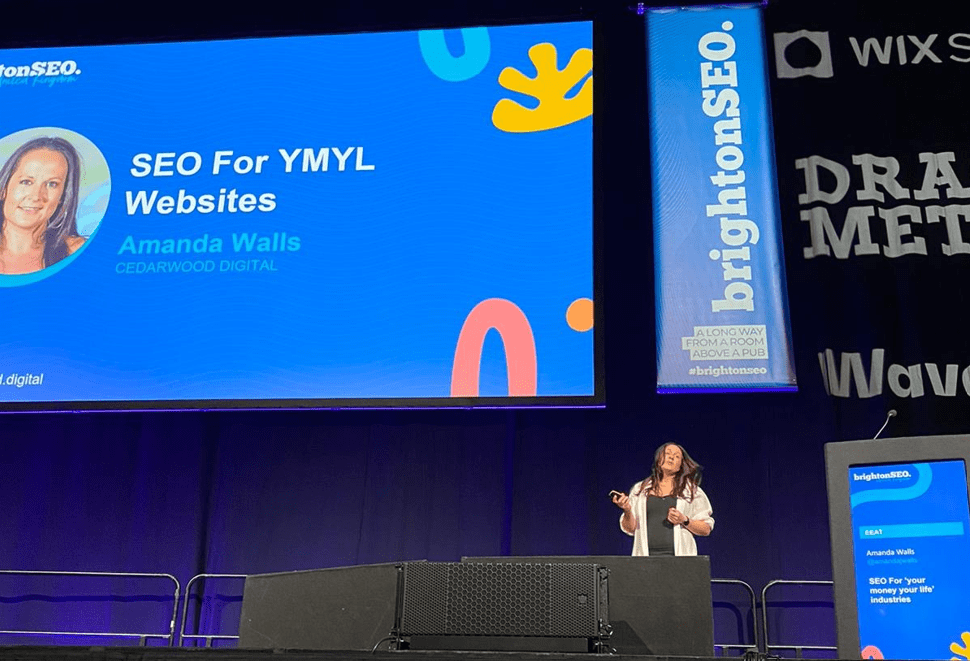How can I measure Digital PR return on investment when it has such varied effects and benefits? This is a question PRs frequently encounter. You want to show your clients and stakeholders that the work you’re doing is having a positive impact, so what are the best KPIs to highlight?
At Cedarwood Digital, we know that measuring the success of a campaign can be tricky. We’re lucky to work with brands of many sizes, from a breadth of sectors – clients want a variety of things and prioritise different metrics. As such, we find that a multifaceted approach to measuring campaigns is the best way to reach an accurate assessment.
This post will explain the different metrics you can use to track Digital PR success; you’ll hopefully gain a good understanding of the different softwares and criteria to consider. No matter the nature of a campaign or client, this guide will put you in good stead to present a precise evaluation.
Why should we care about metrics?
There has long been debate within the industry when it comes to KPIs for Digital PR. For many years, the only metric many clients (and agencies) cared about was the number of links a campaign earned.. However, a campaign’s impact goes much further than just links. “There’s more to link building than quantity – in fact in many cases one super relevant high quality link can outweigh the performance of many poor quality links – so when it comes to measuring digital PR how do you prove effectiveness when you’re not working with a volume metric?”
It’s important to consider which metric is most important to your business and stakeholders, depending on your goals. This will ensure that you’re all working for the same thing. You might think you just want as many pieces of coverage and backlinks as possible, but dig a little deeper and you may find more specific goals. Do you want to boost the visibility of certain parts of your website? Perhaps your main goal is driving referral traffic, or growing brand awareness by generating links in key target publications? Determine which focus area should be prioritised and this will help you to create the best possible outcomes and keep everyone happy.
Measuring the success of campaigns will also help you determine why a campaign did or didn’t work. With this information you can then adapt subsequent strategies, and keep learning and improving. This is vital when it comes to providing commercial return for the client. After all, they want to see that you are providing a return on their investment. Tracking the relative success of different campaigns and effective, and less effective, techniques will help ensure you achieve the ultimate aim – customer conversions.
Quantifying a Digital PR campaign is also a great way to encourage motivation within your team. Having clear aims in mind and celebrating successes will help ensure a productive and positive morale.
➡️At Cedarwood Digital we talk about two categories of Digital PR metrics: owned metrics and shared metrics. Owned metrics are those a Digital PR team has control over. Then, shared metrics are things we can have a positive impact on but that are also impacted by other factors. For example, corresponding SEO strategies, and external business components.
Owned Metrics
Backlinks
Links from publications to your website are a significant indicator of a campaign’s success. A link goes beyond a brand mention in its ability to have a substantial impact on SEO. Google loves a backlink because of the E-E-A-T signals it demonstrates. A good quality, quantity and relevancy of backlinks are seen as big votes of confidence that will improve the site’s SERP ranking, and drive traffic.
However, not all links are equal and, to get an accurate sense of a campaign’s success, we’d recommend evaluating different backlink factors. In addition to measuring the quantity of backlinks, you’ll want to consider their quality, relevancy and diversity.
The best way to deduce backlink quality is to look at the relevancy of the link, the website it’s coming from, and the content of the article. This can then be used alongside metrics like Domain Rating, Domain Authority and Trust Flow. These are all measurements of quality, created by SEO tools Ahrefs, Moz and Majestic. Each will give a numerical score to a domain, with a higher score indicating a better, more authoritative website. However, be careful not to use these metrics in isolation. Some spam directories have a high DR and likewise, backlinks from lower scoring sites should not be discounted. A good amount of coverage on relevant sites, no matter their rating, will have a positive impact on your ranking.
In line with this, it’s also a good idea to track the diversity of your backlinks. A successful campaign is not only demonstrated by a high volume of links, but also appearance in new unique referring domains, wishlist publications, and link gap placements. When pulling together a tracking system, ensure to include measures of the nature of the link, not only the number.
While some people will only report on Follow links, we’d advise measuring all types of links. No-follow links, syndicated links and affiliate links should not be discounted merely because they aren’t ranking factors for Google. They can all positively impact brand awareness and, as people start associating your client’s name with key industry terms, this will bring in more high-intent traffic to your site.
Deeper Page Linking
Another key metric here is quality links to deeper pages within the website. Using Digital PR to build links to a specific high-return landing page can push value directly into that page – helping your client outrank their competitors and bring in more conversions over time. Therefore, when determining the success of a campaign, keep your eye out for the number of deeper page links. They will show your client that you’re boosting organic visibility to high-intent pages, demonstrating the possibility of future ROI.
Brand Mentions
The amount of times your brand name is published is one of the simplest Digital PR metrics to track. Brand mentions can present in a variety of ways, not only from online news outlets, but also print, audio and video mentions. Plus, your brand mentions will exceed just links. Some outlets won’t link to your website but you should keep your eyes peeled for this coverage as it will still have some positive impact. Any mention of a company’s name is great for brand awareness – the more customers hearing about your business, the better.
However, it’s worth mentioning that Google doesn’t acknowledge brand mentions as part of a link building campaign, due to the algorithm’s inability to identify the context of the mention. Therefore, whilst they’ll help to build your overall brand, brand mentions won’t function as direct trust signals to Google so shouldn’t be overly emphasised.
Wanting to keep track of your brand mentions? Some of the best measurement tools to find these all-important mentions are Google Alerts, Talkwalker Alerts, Ahrefs mention alert and good old fashioned Google searches!
Email Tracking
The last owned metrics to keep an eye on are email opens and click-through rates. With this, you can identify if your pitches could be improved, and whether your story is compelling. Although lots of factors impact the length of time taken for a journalist to open your email, it definitely indicates how much your subject has caught their attention. Meanwhile, if your open rates are good but your click through rate is on the lower side, this could be a sign that your email content needs adapting.
Shared Metrics
Business Goals
The most important metric for your clients is the real financial impact of Digital PR and how your campaigns are tangibly helping them reach their business goals. Achieving high-quality, relevant backlinks is a meaningful metric and good achievement, but the big question your clients will be asking is ‘what will those links do?’
Businesses put resources into Digital PR to get a return on their investment – they want more conversions and revenue as a result of your efforts. You need to have a strong understanding of what these links are achieving, to then illustrate this to the stakeholders.
A good Digital PR strategy isn’t just about building links, it’s useful to think about links as the first step of a chain, ending in revenue. Building backlinks improves rankings and brand awareness, which increases the site’s visibility and boosts organic traffic. This combines to bring in lots of high-intent clicks, and then the all-important conversions.
Keyword Rankings
As Digital PR is usually one element of a wider SEO strategy, one of the larger goals you should be working towards is increasing keyword rankings and online visibility. Building high quality, relevant links to key commercial pages, when combined with on-site optimisations, can have a big impact on overall rankings. However, as previously mentioned, while Digital PR can help in this area, there are a range of other factors impacting it too, so this is why we class this as a shared metric.
Do remember though that keyword ranking is a slow-burner and a successful PR campaign may not drive an immediate boost in visibility. This is why reporting on the previously mentioned owned metrics is a good way to highlight success straight away.
Site Traffic
Site traffic can be impacted by Digital PR, whether through direct referral traffic from successful placements, or just from overall visibility improvements. However, as with rankings, Digital PR is just one of many factors which can impact traffic. It can still be a good metric to track, as for people who don’t work in SEO, it can be seen as a more tangible indicator of success.
Social Shares
Whilst the extent to which social media can positively impact SEO is debatable, it’s generally acknowledged that any social media coverage is a valuable thing when it comes to growing brand awareness. Social media buzz around your story can also help boost the campaign’s reach, which can in turn lead to more coverage and backlinks. Social listening tools like Brandwatch and Pulsar can be used to track social media mentions, as well as the sentiment of the discussion.
Deliver successful Digital PR Campaigns with Cedarwood Digital
At Cedarwood Digital our Digital PR team has an excellent track record of executing successful campaigns which land coverage and sales for our clients. We closely monitor our metrics to ensure that we are constantly updating and improving our strategies. To discuss how we can bring our successful Digital PR techniques to your company’s growth plan, get in touch with us today.



![[blog]_[Director Amanda On The Main Stage At Brighton SEO]_[Blog Picture]](https://cedarwood.digital/wp-content/uploads/2024/04/wpimage-id13321width562pxheightautosizeSluglargelinkDestinationnone-figure-classwp-block-image-size-large-is-resizedimg-srchttpscedarwood.digitalwp-contentuploads202507Image-1-1024x-3-900x506.png)
![[blog]_[Core Web Vitals - What Is It & How Do I Find Out If I Pass?]_[Blog Picture]](https://cedarwood.digital/wp-content/uploads/2024/04/Untitled-design-41-900x506.png)
![[blog]_[How Digital PR Works To Improve SEO Results]_[Blog Picture]](https://cedarwood.digital/wp-content/uploads/2024/04/wpimage-id13321width562pxheightautosizeSluglargelinkDestinationnone-figure-classwp-block-image-size-large-is-resizedimg-srchttpscedarwood.digitalwp-contentuploads202507Image-1-1024x-57-900x506.png)
![[blog]_[Reactive Digital PR: What Is It And How To Do It]_[Blog Picture]](https://cedarwood.digital/wp-content/uploads/2024/03/Untitled-design-52-900x506.png)
![[blog]_[70 Free Data Sources For Your Digital PR Campaigns (All In One Place!)]_[Blog Picture]](https://cedarwood.digital/wp-content/uploads/2024/03/wpimage-id13321width562pxheightautosizeSluglargelinkDestinationnone-figure-classwp-block-image-size-large-is-resizedimg-srchttpscedarwood.digitalwp-contentuploads202507Image-1-1024x-59-900x506.png)
![[blog]_[Digital PR Ideation: How To Come Up With Ideas]_[Blog Picture]](https://cedarwood.digital/wp-content/uploads/2024/02/Untitled-design-59-900x506.png)
![[blog]_[Link Reclamation: How To Turn Brand Mentions Into Links]_[Blog Picture]](https://cedarwood.digital/wp-content/uploads/2024/02/Untitled-design-60-900x506.png)
![[blog] [northern digital awards] [blog picture]](https://cedarwood.digital/wp-content/uploads/2024/01/How-we-delivered-100-top-tier-links-by-jumping-on-a-trending-topic-900x506.png)

![[blog]_[How Can You Use AI For Your Digital PR Strategy]_[Blog Picture]](https://cedarwood.digital/wp-content/uploads/2024/01/Untitled-design-61-900x506.png)
![[blog]_[How To Measure The Success Of Your Digital PR Campaigns]_[Blog Picture]](https://cedarwood.digital/wp-content/uploads/2024/01/Untitled-design-62-900x506.png)
![[blog]_[The Power Of Using Expert Commentary In A Digital PR Campaign]_[Blog Picture]](https://cedarwood.digital/wp-content/uploads/2023/12/Untitled-design-63-900x506.png)
![[blog]_[The Top Tools for your Digital PR Strategy]_[Blog Picture]](https://cedarwood.digital/wp-content/uploads/2023/12/Untitled-design-64-900x506.png)